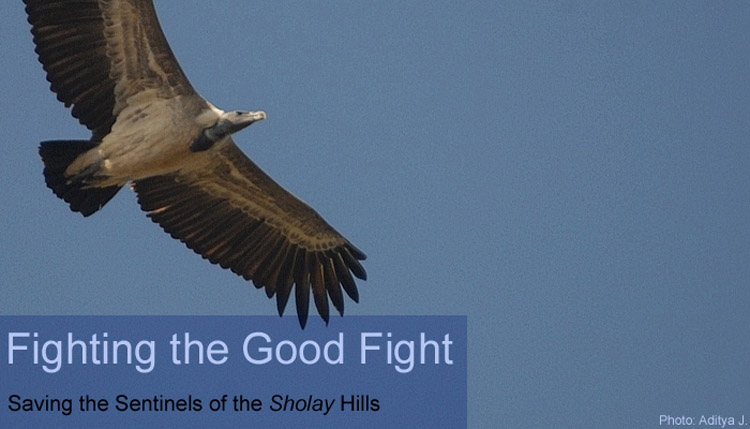Fighting the Good Fight
A group of students in the MSc. Wildlife and Conservation programme in NCBS recently made a short (7-min) documentary film about a place that is host to a unique but fast disappearing population of birds. It is 50 km from Bangalore, yet hardly any of us know about the dangers faced by its wildlife. This is the story of how and why the documentary was made and what the students learned from the experience. (Watch the documentary, Awaiting Death on YouTube here.)
Near the south-western tip of the state of Karnataka is the town of Ramnagaram, population - seventy thousand. If you climb one of the rocky hilltops that dot the surrounding landscape, tilt your head and listen carefully – you can still hear Gabbar’s laughter; loud and melodramatic; yet spine-tingling.
Students in the Master’s programme in Wildlife and Conservation from NCBS often make weekend trips away from the city. In August of 2008, on one such trip a group of students went to the dusty hills where Sholay was made. Gabbar Singh however, was the last thing on their minds. The fast-disappearing, rocky hills of Ramnagaram are the last refuge in Southern India of the critically endangered, long-billed vulture. And this worries them. What’s more, on every subsequent visit to Ramnagaram, things only seemed to be getting worse.
But what can a group of students do in the face of quarrying companies and the hotel industry lobbying for the use of land and resources? After all, these businesses cater to us, an ever-hungry market – the growing city of Bangalore. How does one navigate the corridors of power in the Forest Department, side-step or cut through the red tape? Not step on the wrong toes yet push to have Ramnagaram declared a sanctuary – for that must be done, if the vulture is to be saved. These things, a student does not know how to do. But can something be done? Anything?
Enter the course on Communication and Advocacy in September of 2009. Aditya Joshi, Nisarg Prakash, Girish Punjabi, Tarun Nair, Nishant M. S., Rajat Nayak and Krishnapriya Tamma needed to do a project on communicating science - a choice between making a presentation, a poster, a website or a documentary. They jumped at the idea of making a short documentary about Ramnagaram and its vultures. This would help spread awareness about the ecological value of Ramnagaram, with the ultimate goal being to build enough support - in the public and in the Indian Forest Services - for the declaration of the region as a vulture sanctuary.
The visits to Ramnagaram took on a new sense of purpose. Locals were interviewed and experts on the area’s ecology were consulted. Many hours of leg work in the field were spent collecting footage – shots of the village, the hills and rocky outcrops, and of course, the vultures themselves. Girish wrote up a script that Krishnapriya narrated. Aditya edited video and sound and pieced the movie together. Their message was clear. The hills and valleys of Ramnagaram are host to a valuable species. They are in danger and the vultures, while still breeding, are threatened. Ramnagaram must be protected.
When asked what lessons were learnt from the experience – Nisarg enthusiastically pointed out the importance of going outdoors and actually doing something hands-on. While this is hardly a new idea, Nisarg’s excitement is testament to how seldom we actually do it. The students also report that the documentary is being shown to Forest Department personnel and is also being dubbed in Kannada, for the benefit of the locals. This last step is an important one, they say, as it is awareness among the locals themselves that will probably have the most lasting and largest impact on policy.
So, what happens to the hills and rocks of Ramnagaram now? Thanks to Aditya and his team, at least we know there is a problem. The rest is up to us. Will quarries deface the countryside? Or will the vultures find safe haven there, soaring, surveying the granite-dotted landscape, occasionally looking down, into a camera’s lens.

Comments
Post new comment